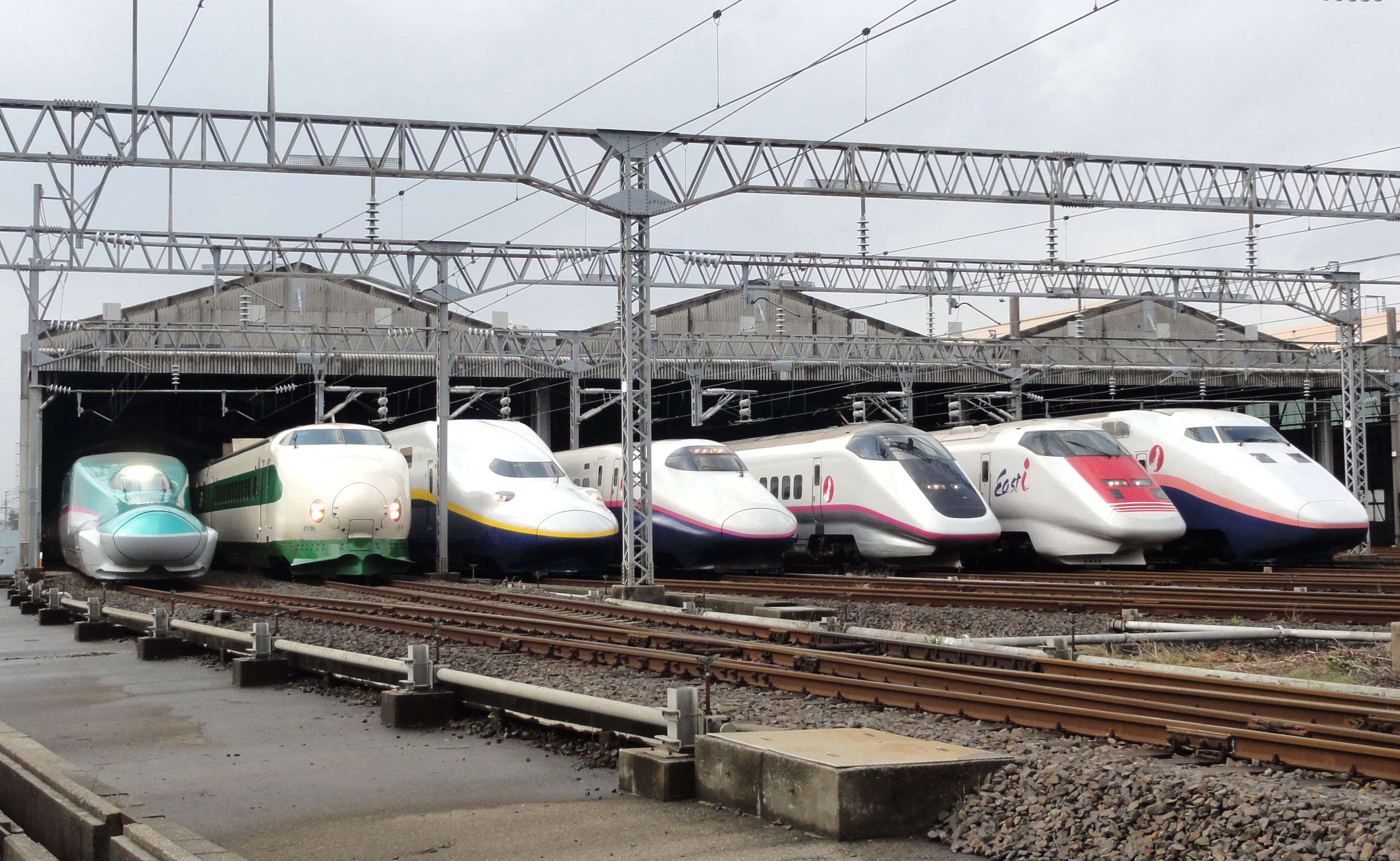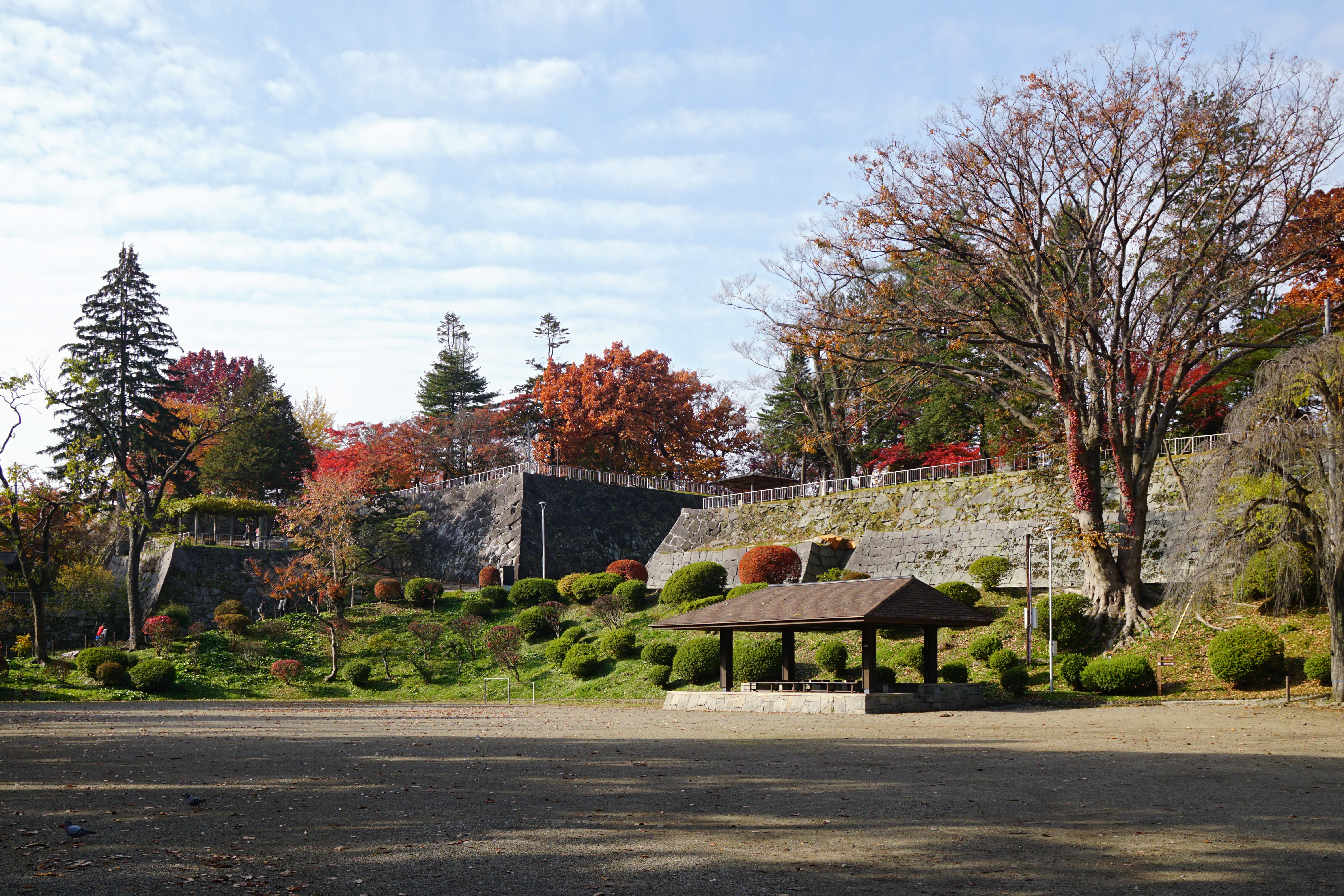|
Japan National Route 104
is a national highway of Japan connecting the cities of Hachinohe in southeastern Aomori Prefecture and Ōdate in northern Akita Prefecture in northern Japan. It travels east to west and has a total length of . Route description National Route 104 has a total length of . From its junction with National Route 454 in Hachinohe to the beginning of its unsigned concurrency with National Route 103 in Kazuno, the highway is known as the Shirahagi Line. History National Route 104 was established by the Cabinet of Japan as a second-class national highway in 1953. The system of different classes of national highways was abolished in 1970, in turn, the highway was designated as National Route 104. Major intersections All junctions listed are at-grade intersection An intersection or an at-grade junction is a junction where two or more roads converge, diverge, meet or cross at the same height, as opposed to an interchange, which uses bridges or tunnels to separate different road ... [...More Info...] [...Related Items...] OR: [Wikipedia] [Google] [Baidu] |
Hachinohe, Aomori
is a city located in Aomori Prefecture, Japan. , the city had an estimated population of 221,459, and a population density of 725 persons per km2 in 96,092 households, making it Aomori Prefecture's second largest city by population. The city has a total area of . History The area around Hachinohe has been occupied since prehistoric times, and was a major population center for the Emishi people. Numerous Jōmon period remains have been discovered within the borders of Hachinohe. The area was nominally under control of the Northern Fujiwara in the Heian period, and became part of the holdings granted to the Nanbu clan after the defeat of the North Fujiwara by Minamoto no Yoritomo in the Kamakura period. The Nanbu established numerous horse ranches, accompanied by numbered fortified settlements. During the Edo period, it was initially part of Morioka Domain, but in 1664 the Tokugawa shogunate authorized the creation of a separate 20,000 ''koku'' Hachinohe Domain for a junior line ... [...More Info...] [...Related Items...] OR: [Wikipedia] [Google] [Baidu] |
Shinkansen Jre
The , colloquially known in English as the bullet train, is a network of high-speed railway lines in Japan. Initially, it was built to connect distant Japanese regions with Tokyo, the capital, to aid economic growth and development. Beyond long-distance travel, some sections around the largest metropolitan areas are used as a commuter rail network. It is operated by five Japan Railways Group companies. Over the Shinkansen's 50-plus-year history, carrying over 10 billion passengers, there has been not a single passenger fatality or injury on board due to derailments or collisions. Starting with the Tokaido Shinkansen () in 1964, the network has expanded to currently consist of of lines with maximum speeds of , of Mini-Shinkansen lines with a maximum speed of , and of spur lines with Shinkansen services. The network presently links most major cities on the islands of Honshu and Kyushu, and Hakodate on northern island of Hokkaido, with an extension to Sapporo under constru ... [...More Info...] [...Related Items...] OR: [Wikipedia] [Google] [Baidu] |
Lake Towada
is the largest crater lake in Honshū island, Japan. Located on the border between Aomori and Akita prefectures, it lies 400 meters (1,800 ft) above sea level and is 327 m (1,073 ft) deep, drained by the Oirase river. With a surface area of 61.1 km², Towada is Japan's 12th largest lake, its bright blue color is due to its great depth. The lake is roughly circular, with two peninsulas extending from its southern shore approximately one-third into the center of the lake. The lake is a popular tourist destination. Location Lake Towada is located approximately northeast of Tokyo, divided between the municipalities of Towada, Aomori and Kosaka, Akita. It forms part of the northern section of Towada-Hachimantai National Park Geology Lake Towada occupies the caldera of a stratovolcano still regarded as an active volcano. This volcano became active around 200,000 years ago, and through repeated eruptions and pyroclastic flows, especially 55,000 and 36,000 an ... [...More Info...] [...Related Items...] OR: [Wikipedia] [Google] [Baidu] |
Takko
is a town located in Aomori Prefecture, Japan. , the town had an estimated population of 5,353, and a population density of 22 persons per km2, in 2,142 households. The total area of the town is . Geography Takko occupies the far southeast corner of Aomori Prefecture, south of the Hakkōda Mountains. Much of the town is mountainous with peaks ranging from 700 to 1000 meters. The mountainous area is home to many indigenous plant and animal species. Wildlife includes Japanese macaque monkeys, '' kamoshika,'' ''tanuki,'' and Asian black bears. Neighbouring municipalities Aomori Prefecture * Sannohe District **Sannohe Iwate Prefecture * Ninohe * Hachimantai Akita Prefecture *Kazuno Climate The town has a cold Humid continental climate characterized by cool, short summers and long, cold winters with extremely heavy snowfall (Köppen climate classification ''Dfa''). The average annual temperature in Takko is 8.8 °C. The average annual rainfall is 1375 mm with September ... [...More Info...] [...Related Items...] OR: [Wikipedia] [Google] [Baidu] |
Sannohe, Aomori
is a town located in Aomori Prefecture, Japan. , the town had an estimated population of 9,814 in 4260 households, and a population density of 65 persons per km2. The total area of the town is . Geography Sannohe occupies an inland area in southeast corner of Aomori Prefecture, south of the Hakkōda Mountains. The terrain is relatively flat, with mountains extending in the northwestern part of the town. The Mabechi River flows from north to south through the center of the town. Neighbouring municipalities Aomori Prefecture * Nanbu *Takko * Shingō Iwate Prefecture * Ninohe Akita Prefecture *Kazuno Climate The town has a cold maritime climate characterized by cool short summers and long cold winters with heavy snowfall (Köppen climate classification ''Cfa''). The average annual temperature in Sannohe is 10.2 °C. The average annual rainfall is 1259 mm with September as the wettest month. The temperatures are highest on average in August, at around 22.9 °C, and ... [...More Info...] [...Related Items...] OR: [Wikipedia] [Google] [Baidu] |
Ninohe, Iwate
is a city located in Iwate Prefecture, Japan. , the city had an estimated population of 26,344, and a population density of 63 persons per km2 in 11,803 households. The total area of the city is . Geography Ninohe is located in far north-center Iwate Prefecture, bordered by Aomori Prefecture to the north. The northern end of the Kitakami Mountains, the 852.2 meter Mount Oritsume is in Ninohe. Approximately 70% of the city area is mountainous and forested. The upper reaches of the Mabechi River flows through the city. A portion of the city is within the borders of the Oritsume Basenkyō Prefectural Natural Park. Neighboring municipalities Aomori Prefecture * Nanbu *Sannohe *Takko Iwate Prefecture * Hachimantai * Kunohe * Karumai * Ichinohe Climate Ninohe has a humid continental climate (Köppen ''Dfb'') characterized by mild summers and cold winters with heavy snowfall. The average annual temperature in Ninohe is 9.7 °C. The average annual rainfall is 1248 mm with Se ... [...More Info...] [...Related Items...] OR: [Wikipedia] [Google] [Baidu] |
Morioka
is the capital city of Iwate Prefecture located in the Tōhoku region of northern Japan. On 1 February 2021, the city had an estimated population of 290,700 in 132,719 households, and a population density of . The total area of the city is . Geography Morioka is located in the in central Iwate Prefecture, at the confluence of three rivers, the Kitakami, the Shizukuishi and the Nakatsu. The Kitakami River is the second largest river on the Pacific side of Japan (after the Tone River) and the longest in the Tōhoku region. It runs through the city from north to south and has a number of dams within the city boundaries, including the Shijūshida Dam and Gandō Dam. An active volcano, Mount Iwate, dominates the view to the northwest of the city. Mount Himekami is to the north and Mount Hayachine can sometimes be seen to the southeast. Surrounding municipalities Iwate Prefecture *Hanamaki * Hachimantai * Takizawa * Miyako *Shizukuishi * Kuzumaki * Shiwa *Yahaba * Iwaizumi Demo ... [...More Info...] [...Related Items...] OR: [Wikipedia] [Google] [Baidu] |
Karumai, Iwate
is a town located in Iwate Prefecture, Japan. , the town had an estimated population of 8,895 in 3769 households, and a population density of 36 persons per km². The total area of the town is . Geography Karumai is located in far northcentral Iwate Prefecture, bordered by Aomori Prefecture to the north. Neighboring municipalities Aomori Prefecture *Hachinohe * Nanbu * Hashikami Iwate Prefecture * Ninohe *Kuji * Hirono * Kunohe Climate Karumai has a humid oceanic climate (Köppen climate classification ''Cfa'') characterized by mild summers and cold winters. The average annual temperature in Karumai is 9.5 °C. The average annual rainfall is 1209 mm with September as the wettest month and February as the driest month. The temperatures are highest on average in August, at around 22.5 °C, and lowest in January, at around -2.4 °C. Demographics Per Japanese census data, the population of Karumai peaked at around the year 1960 and has steadily declined over th ... [...More Info...] [...Related Items...] OR: [Wikipedia] [Google] [Baidu] |
Kenyoshi Station
is a railway station on the Aoimori Railway Line in the town of Nanbu in Aomori Prefecture, Japan, operated by the third sector railway operator Aoimori Railway Company. Lines Kenyoshi Station is served by the Aoimori Railway Line, and is 14.8 kilometers from the terminus of the line at Metoki Station. It is 632.1 kilometers from Tokyo Station. Station layout Kenyoshi Station has two ground-level opposed side platforms serving two tracks connected to the station building by a footbridge. The station is staffed. Platforms History Kenyoshi Station was opened on July 1, 1897, as a station of the Nippon Railway. When the Nippon Railway was nationalized on November 1, 1906, it became a station on the Tōhoku Main Line of the Japanese Government Railways (JGR) and later the Japanese National Railways (JNR). Freight operations were discontinued from November 1982. The station has been managed from Hachinohe Station since February 1983. With the privatization of the JNR on Ap ... [...More Info...] [...Related Items...] OR: [Wikipedia] [Google] [Baidu] |
Nanbu, Aomori
250px, Hoko-ji, the clan temple of the Nanbu clan is a town located in Aomori Prefecture, Japan. , the town had an estimated population of 17,754, and a population density of 120 persons per km2 in 7433 households. The total area of the town is . Geography Nanbu is located in southeastern of Aomori Prefecture, in the eastern part of Sannohe District. The Mabechi River flows from east to west in the center of the town. The terrain is flat along the Mabuchi River, but there are few flatlands and most of the town is hilly. In the southern part of the town, Mt. Nakui has an elevation of 615 meters. Neighbouring municipalities Aomori Prefecture * Sannohe District **Sannohe ** Shingō **Gonohe *Hachinohe Iwate Prefecture * Ninohe * Karumai Climate The town has a cold maritime climate characterized by cool short summers and long cold winters with heavy snowfall (Köppen climate classification ''Cfa''). The average annual temperature in Nanbu is 10.0 °C. The average annual rain ... [...More Info...] [...Related Items...] OR: [Wikipedia] [Google] [Baidu] |
Nangō, Aomori
was a village located in Sannohe District in central Aomori Prefecture, Japan. Nangō Village was founded on April 1, 1889. On March 31, 1957 it merged with the neighboring villages of Shimamori and Nakazawa. On March 31, 2005, Nangō was merged into the expanded city of Hachinohe, and thus it no longer exists as an independent municipality. An inland village, Nangō had an agriculture-based economy. At the time of its merger, Nangō had an estimated population of 6,440 and a population density Population density (in agriculture: Stock (other), standing stock or plant density) is a measurement of population per unit land area. It is mostly applied to humans, but sometimes to other living organisms too. It is a key geographical ... of 70.67 persons per km2. The total area was 91.13 km2. Dissolved municipalities of Aomori Prefecture {{aomori-geo-stub ... [...More Info...] [...Related Items...] OR: [Wikipedia] [Google] [Baidu] |
Hachinohe Expressway
The is a 4-laned national expressway in the prefectures of Iwate and Aomori in the Tōhoku region of Japan. It is a spur of the Tōhoku Expressway, primarily serving the city of Hachinohe. Signed as E4A, it is owned and operated by East Nippon Expressway Company. Route description The expressway is officially referred to as the Tōhoku Jūkan Expressway Hachinohe Route. The route connects the city of Hachinohe with the Tōhoku Expressway in Iwate Prefecture. From the terminus at Hachinohe-kita Interchange, there are plans to extend the route northward to the terminus of the Aomori Expressway through a series of toll roads. History The Hachinohe Expressway was opened on November 27, 1986, with the Momoishi Extension to the Second Michinoku Toll Road opening later in 1995. After the Great East Japan Earthquake the expressway was made free to use temporarily for those who were impacted by the disaster. Tolls resumed in March 2012. Future Starting at the Momoishi Road Extension, ... [...More Info...] [...Related Items...] OR: [Wikipedia] [Google] [Baidu] |

.png)





